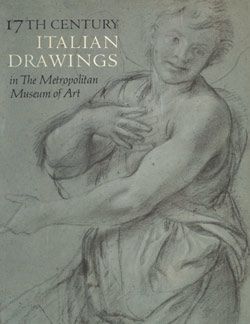Virtue Crowned by Honor
Carlo Maratti Italian
Not on view
During the pontificate of Clement X Altieri (r. 1670–76), his family palace on the Piazza del Gesù in Rome was enlarged and redecorated. Carlo Maratti, a gifted draftsman and the leading baroque painter in Rome, was commissioned to paint the main room between 1674 and 1677, but only the fresco that fills the long, narrow central section of the vault of Palazzo Altieri was executed. The undecorated portions of the vault were to contain allegorical figures representing Religion, Faith, Divine Wisdom, and Evangelical Truth.
Together with three other sheets in the Metropolitan Museum (inv. nos. 64.295.1, 66.137 and 66.53.3) the present study relates to the Altieri decoration and constitutes a preliminary sketch by Maratti for an Allegorical Virtue crowned by Honor. Maratti executed the figure on blue paper with a quick sketch in pen and ink, highlighted with white gouache, and developed this dynamic group on a second, highly-finished drawing in red chalk, also in the Museum’s collection (inv. 64.295.1).
In the present drawing Virtue wears the lion's skin over her head, and Honor holds a cornucopia, as the text dictates. These features are missing in the second study, but there, lightly indicated in chalk at the bottom of the sheet, appears the "trifauce cane." Other studies for Virtue Crowned by Honor are in the Albertina in Vienna, the National Gallery of Scotland, Edinburgh, and the Academia de San Fernando, Madrid.
According to the artist’s biographer, Giovanni Pietro Bellori (1613-1696) Maratta executed the painted decoration for the spandrels of the Palazzo Altieri but, in reality, the artist never completed more than the central panel of the ceiling of the chamber, which represents an Allegory of Clemency (in honor of his patron Clement X). Bellori describes the intended scheme, saying that the spandrels at one end of the room were to contain Allegories of Religion and Faith, while at the other end, over the entrance door were to be an Allegory of Divine Wisdom and an Allegory of Evangelical Truth.
Bellori describes the side walls of the room in the following words: "fra le tre laterali a destra, Roma Sacra, il Tempo, la Pace, la Virtù, l'onore, e ne tre altri intermezzi opposti le quattro parti del Mondo Europa, Asia, Africa, ed America divote alla Chiesa..."(trans.: "in the three laterals in the right Sacred Rome, Time, Peace, Virtue, Honor, and in the three spaces on the opposite wall the four parts of the world Europe, Asia, Africa and America all honoring the Church..."). For other preparatory studies for the decoration of the Great Hall of the Palazzo Altieri in the Metropolitan Museum of Art see inv. nos. 64.295.1 (Virtue crowned by Honor), 66.53.3 (Allegory of Peace), 66.137 (Allegory of Divine Wisdom or Divina Sapienza), 2008.334.1 (Study of a Putto Seated on a Corbel in a Shell Niche), and 65.206 (Plan for a Ceiling and Nude Figures).
(F.R.)
Due to rights restrictions, this image cannot be enlarged, viewed at full screen, or downloaded.






